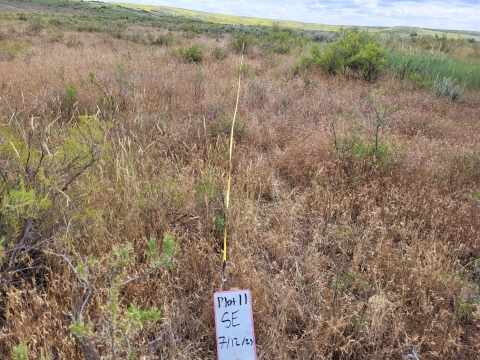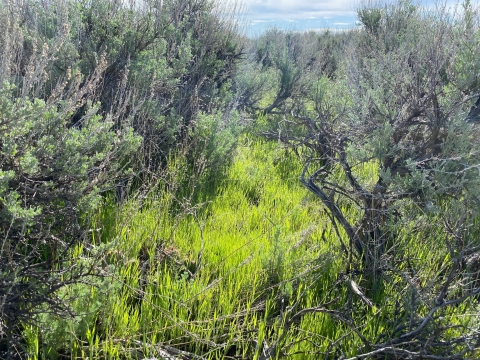With the release of the Sagebrush Conservation Design (SCD) in 2022, rangeland researchers made an extraordinary attempt to map the habitat quality of the imperiled sagebrush sagebrush
The western United States’ sagebrush country encompasses over 175 million acres of public and private lands. The sagebrush landscape provides many benefits to our rural economies and communities, and it serves as crucial habitat for a diversity of wildlife, including the iconic greater sage-grouse and over 350 other species.
Learn more about sagebrush steppe on the scale of the entire biome to evaluate sagebrush condition and prioritize areas for conservation investment. Now, in 2024, a special issue of Rangeland Ecology & Management brings together a suite of new research that leverages the SCD to answer big questions about sagebrush conservation. Learn all about this special issue at the Sagebrush Conservation Gateway.
The Missouri River slices through the landscape of north-central Montana. Before it meets the earthen mass of the Fort Peck Dam, there’s a place where the river still floods regularly, filling the large cottonwood galleries lining its floodplain. From there, steep coulees lined with ponderosa pine and Douglas fir meet grassy ridges that climb up nearly 1,000 feet to sage-steppe plains.
Sagebrush habitat at the Charles M. Russell National Wildlife Refuge Complex is some of the best in the National Wildlife Refuge System. Paul Santavy, the U.S. Fish and Wildlife Service refuge manager and project leader at the complex, said the refuge is host to somewhere around 150,000 acres of core sage grouse areas—and supports many other species besides.
“This sagebrush ecosystem is so important,” he said. “There are so many different species that are obligates to a sagebrush community and they can’t live anywhere else.”
A 2024 paper published in Rangeland Ecology & Management agrees. The study, which identifies core sagebrush habitat found on national parks and national wildlife refuges, points out two of the complex’s six refuges (UL Bend and Charles M. Russell National Wildlife Refuges) as the cream of the crop when it comes to sagebrush habitat. Both made the list of the top five wildlife refuges that provide what’s considered “core sagebrush areas” under the Sagebrush Conservation Design, a geospatial decision support framework that identifies the most resilient sagebrush habitat in the western United States. Besides offering some of the best habitat found on U.S. Fish and Wildlife Service-managed land, the two refuges also provide connectivity to the largest blocks of sagebrush habitat in Montana, which are managed by both private landowners and the Bureau of Land Management.
But, like his ranching neighbors and land managers across the sagebrush sea, Santavy is staring down the barrel of a big problem: invasive annual grasses. A flash drought in 2017 kick-started a cycle of Japanese brome expansion on the CMR complex and surrounding areas. A lack of rainfall in April and May, combined with soaring temperatures in July, meant that native grasses and forbs didn’t grow well that year. Then, heavy rains in September and October created perfect growing conditions for Japanese brome, which took advantage of the moisture and the lack of competition to spread wildly.
Santavy said the pulse of Japanese brome that year made him wonder if the refuge had tipped over a threshold with invasive annual grasses. A team of refuge specialists used satellite imagery and ground checks over the next several years to identify the types and spread of invasive annual grasses on the landscape. Because they were looking at millions of acres of land to cover, they used core sage grouse habitat to focus their search and then worked on getting finer scale tools to identify where Japanese brome was growing on the refuge complex. Bill Sparklin, the lead author of the research published in Rangeland Ecology & Management, assisted Santavy and his team with the work by modeling where invasive annual grasses existed on the landscape over time. The modeling painted a bleak future for the refuge complex.
“Ecologically, I’m concerned,” Santavy said. “In big years, it really takes over the understory around sage. There isn’t much else. And every year it does really get worse.”
Sparklin said that in the application of Sagebrush Conservation Design, there is a lot of focus on Bureau of Land Management lands and private lands. National parks and national wildlife refuges are often overlooked due to their smaller footprints. This also stems from the directive with which parks and refuges were established: to preserve land from development, not to actively manage it against dynamic threats like invasive annual grass. But, he said, that small land footprint means that parks and refuges often have more capacity per acre to manage habitat. That’s why his research team thought it was important to specifically apply Sagebrush Conservation Design to those lands in the analysis.
“The flip side of that [capacity] is that there’s a hesitance to manage because parks and refuges are considered these ‘protected areas,’” Sparklin said. “There’s a legacy idea of once we give it the designation of protecting it, it stops exploitation and what used to be the threats. But when we think about climate change climate change
Climate change includes both global warming driven by human-induced emissions of greenhouse gases and the resulting large-scale shifts in weather patterns. Though there have been previous periods of climatic change, since the mid-20th century humans have had an unprecedented impact on Earth's climate system and caused change on a global scale.
Learn more about climate change , fire, and invasive species invasive species
An invasive species is any plant or animal that has spread or been introduced into a new area where they are, or could, cause harm to the environment, economy, or human, animal, or plant health. Their unwelcome presence can destroy ecosystems and cost millions of dollars.
Learn more about invasive species , that designation doesn’t address those threats, so we need to think about active management a lot more.”
Sparklin’s work—both the large-scale research showing important sagebrush habitat across the West and the more focused modeling for the refuge—convinced Santavy that action was needed if the refuge wanted to combat the Japanese brome and conserve its sagebrush landscapes. A never-before-seen influx of funding from the Bipartisan Infrastructure Law Bipartisan Infrastructure Law
The Bipartisan Infrastructure Law (BIL) is a once-in-a-generation investment in the nation’s infrastructure and economic competitiveness. We were directly appropriated $455 million over five years in BIL funds for programs related to the President’s America the Beautiful initiative.
Learn more about Bipartisan Infrastructure Law and Inflation Reduction Act provided the refuge with the opportunity to apply the herbicide Rejuvra to combat Japanese brome across the two refuges, something that Santavy said his team was hesitant to do at first. In the long run, he said, it’s clear that this work will benefit the sagebrush habitat he manages.
“None of us are taking lightly putting herbicides on a refuge,” he said. “[Sparklin’s work] gives me the confidence that doing this work is worth it because we are managing two of the most important sage refuges. It gives me the confidence to feel like going through the effort to get the support and funding is the right thing to do.”
Even with historic funding through the Bipartisan Infrastructure Law and Inflation Reduction Act, continued funding and capacity will be needed to turn the tide on invasive annual grasses in the Charles M. Russell National Wildlife Refuge complex. Sparklin’s research emphasizes the potential payoff of such strategic investments.
If you would like to read the full journal article documenting Sparklin’s findings, please see “An assessment of conservation opportunities within sagebrush ecosystems of U.S. national parks and wildlife refuges” in the November 2024 issue of Rangeland Ecology & Management and visit www.sagebrushconservation.org to access the other journal articles supporting the most recent updates to the Sagebrush Conservation Design effort.






